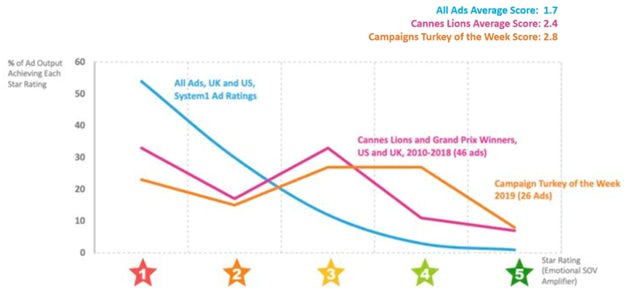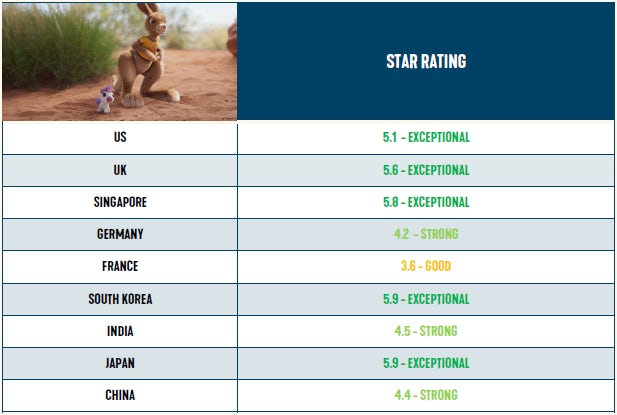Don’t listen to the industry sages, they’re not your ad’s target
Advertising professionals’ view of what makes a good ad is not only biased, it’s usually wrong, as their reaction to Tourism Australia’s last campaign shows.
 A few years back I did a talk in Canada. The next day I was booked onto a very early-morning breakfast TV show to talk about advertising. The host was a fantastically glamorous, bouffant woman, who turned to me at three minutes past fuck-knows-what-time-it-was and asked: “Mark Ritson joins us from Australia, how are things Down Under?”
A few years back I did a talk in Canada. The next day I was booked onto a very early-morning breakfast TV show to talk about advertising. The host was a fantastically glamorous, bouffant woman, who turned to me at three minutes past fuck-knows-what-time-it-was and asked: “Mark Ritson joins us from Australia, how are things Down Under?”
It was a tricky question because Australia was going through the worst bushfires in history. As my host waited patiently for a perky answer, I wrestled with studio lighting, a hangover, giant jetlag and finally opted for brutal honesty. “Well, it’s on fire.”
She looked at me for a second and then slapped my knee and said, “Oh I know. It’s an amazing place.”
I thought to myself that it really was too early in the morning for this and then said, this time with a bit more vehemence: “No, it is literally on fire.”
“Oh I know!” said my host again, upping the volume and enthusiasm another notch while totally missing the point. The rest of the three-minute interview went downhill from there.
The tragic fires of 2019 and 2020 wiped out a huge part of Australian bush and a big slice of its foreign and domestic travel business too. And, just when things were meant to recover, we all know what arrived next. The bastard virus spread far and wide, causing another two-year hiatus in travel demand.
So, when Tourism Australia launched its first post-pandemic global campaign, there was significant nervousness nationwide. Not only was this a huge campaign by any standard of investment. It was also central to the thousands of Australian businesses dependent on foreign travel for their now depleted revenues.
Need to drive bookings
Australia has always been a desired destination, but the central strategic tourism objective is to move enough prospects down the funnel from vague desire to specific visit intention each year to maintain the tourism sector. “We know that Australia consistently ranks high on people’s consideration list,” Tourism Australia’s managing director Phillipa Harrison announced at the kick-off of the new campaign, “but we need to get travellers to take that critical next step and book their holiday to Australia to experience everything we have to offer.”
‘Come and Say G’day’ launched across Tourism Australia’s key international markets in October 2022 with exactly this objective. The campaign used TV ads as well as print, out-of-home, social, digital, editorial and partner advertising to spread its message across all its international target markets.
The ads featured Ruby, a cartoon kangaroo who was generously showing Louie, a visiting unicorn, around some of Australia’s greatest sights. Uluru, Sydney Opera House and the Great Barrier Reef featured, while the classic Aussie anthem ‘We Come from a Land Down Under’ played out in the background.
Domestically, the campaign met with a mixed response. Many marketers were unimpressed with the overall execution. As Traveller magazine reported at the time, Australians were embarrassed by the cliché of a CGI kangaroo and the “lame” and “embarrassing” tone of the campaign.
Elisa Choy, managing director at Maven Data went further. “Is this the best we’ve got to promote tourism to Australia?” she posted on LinkedIn. “CGI kangaroos? We have more to offer to the world than that… epic fail.”
Criticisms came from academic circles too. “What’s the campaign about, really?” marketing lecturer Andrew Hughes asked in The Guardian. “It seems to run true to form from previous campaigns that just use stereotypes. The audience is more mature.”
And it was a similar story on Australian news sites, where advertising professionals weighed in on the ads anonymously. “If this is the best that our industry can do with two years to work on a creative and strategy to boost our economy and remind the international market that Australia exists and is worth the long and expensive flight – let’s all give up and go home,” commented one particularly unimpressed Aussie ad executive on Mumbrella.com.
To be fair, there were many other professional voices Down Under making an alternative point: that domestic marketers living in Australia were, quite literally, not the target market for an ad campaign promoting a holiday in Australia. The seriously smart Kirsty Muddle from Dentsu Australia was one of the few professionals able to demonstrate proper marketing chops.
“This is not for us,” she tried to explain to Traveller magazine back in October. “It’s for the rest of the world. What matters is they like it.”
Market orientation
Note that these more expert voices weren’t saying that Tourism Australia’s ad was a winner. To make that judgement would have opened them up to the same criticism as those slamming the ad. Instead, proper marketers pointed out that those who live in Australia weren’t the market for an ad about a trip to Australia. That they should therefore practice that most venerated of marketing moves – shutting the fuck up and being market-oriented.
Remember market orientation, the prime directive of our discipline? That we are not the consumer, but rather the prime agent for the product. And, as a result, everything we think about our product or service isn’t just potentially wrong, its probably massively biased. Because we aren’t the consumer. We are none of the target segments. We are the person selling the thing. And that means we cannot see what that thing looks like to those encountering it as a consumer. You can’t, as the ancient slice of marketing wisdom puts it, see the label from inside the bottle.
This should be a simple thought, easily grasped. But so many marketers go native and lose all market orientation so quickly and so permanently. They assume their years in advertising mean they can spot a great bit of packaging or a winning ad. That famous Guinness ‘Surfer’ ad, for example, which most of Soho wanks off to every night. It wasn’t particularly outstanding back in 1998, never mind now. But it’s the kind of overstated, clever, award-winning toss that The Industry rates and consumers barely notice and never remember.

Jon Evans and the team at System1 posted a fascinating chart last week from an old analysis of UK and US advertising, which made this point brilliantly. Campaign magazine runs a spot each week where a noted advertising professional nominates a Turkey of the Week – the worst new ad campaign – in their opinion. When System1 looked at these “turkeys” and compared them with the total set of all ads, it discovered, deliciously, that they were significantly more effective on System1’s star rating. Even more deliciously, these turkeys also outperformed the average Cannes Lions and Grand Prix winners too.
You read that right.
The ads that the advertising industry selected as the worst proved more effective than the ones that it selected as the best. Proof, if it were ever needed, that giving out separate awards for creativity and effectiveness makes zero sense. The former feeds into the latter and the latter is all that ultimately matters.
Making the wrong calls
It’s also evidence that marketers need to avoid sniffing their own armpits. When you spend eight hours a day fixated on your brand, browsing industry websites and hanging out with other equally addled people for a decade or more, you don’t become an industry expert, you become a professional idiot.
I’m serious. You make all the wrong calls. You pull campaigns long before they have had chance to be effective. You grow tired of distinctive assets when the target market is only starting to grow accustomed to them. You focus on your brand purpose and ignore basic product performance. You lose, lose, lose because you forgot our founding principle: Thou art not the consumer. Flagellate thyself with this fact.
Of course, that core lesson does not end there. Market orientation is the first step in the journey of doing marketing properly. It turns off all the lights and forces good marketers to look for illumination in the one place where we can find the answers: data from target consumers. The humility of marketing always comes in a double dose. Initially, in understanding that we know nothing. And then, in the realisation that the everyday consumer is the only guru that ever mattered to any decent marketer.
Thou art not the consumer. Flagellate thyself with this fact.
I always get pushback when I make this point. Marketers nod but then subtly challenge whether their instinct is really so off-base. And my answer is always the same. It probably is. But even if it’s not, the only way to be sure is to check with the market anyway. And given the cost of doing those checks is always a tiny fraction of the development costs of the product or service or ad being developed – why fight the obvious and inarguable logic of the market?
A couple of French marketers and a cool agency guy at this point always bring up how research leads to expected outputs that prevent proper breakthroughs. About how Steve Jobs hated data. And how some amazing campaign that the market hated ended up being wildly successful. But that’s all esoteric, outlier crap. And usually bollocks anyway. Jobs died sitting on a mountain of quant and qual data.
It was a lesson not lost on Tourism Australia, which, as part of its campaign planning, pre-tested the shit out of its important new campaign before launch. It initially used mock-ups of the campaign to get an initial steer and then the final version of the ad was tested. So, while the ‘experts’ were busy telling Tourism Australia that their new campaign was an “epic fail”, it was sitting on representative data from each of the main target markets showing two things.
First that their new advertising was going to be well liked by target consumers. Second, based on the thousands of previous ads pre-tested and then post-tested by System1, this was also a campaign that would drive outstanding demand for Australian holidays over the long term. With the exception of France (toujours un cas de ‘vas te faire enculer’), this was a campaign that was going to be exceptionally successful.

The point of market orientation isn’t just that it leads to research, however. It’s usually the first step in the journey to proper marketing, as research builds segmentation, targeting, positioning and eventually better execution. Crucially, it also leads to organisational learning, as marketing teams discover what works and what does not, and adjust accordingly.
And that has proved to be the case for Tourism Australia. The campaign has had a double-digit impact across key target markets. Consideration for Australia as a vacation destination in the next four years has jumped from an average of 25% to 37% of the market. More importantly, intention to visit Australia in the next two years has leapt from 14% pre campaign to 27% after seeing the ads. As the shorter, more promotional partner campaigns kick in, the work to rebuild Australia’s tourism brand is well underway.
‘Come and Say G’Day’ is a fantastic bit of advertising. Not because I think so. Not because you might agree with me. None of us matter. It’s good because the target market think it’s good and because it has achieved the objective it was designed to deliver. The paradox of marketing has always been that we control everything except the one thing that matters – the ultimate response to all our efforts.







